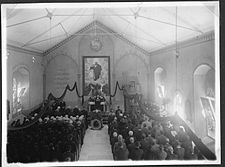Georg Bickel (painter)
Georg Bickel (born December 9, 1862 in Geilsheim , † July 10, 1924 in Mönchsroth ) was pastor of the Bavarian regional church and worked as a painter. His most famous painting, which shows the Ascension of Jesus Christ , has hung in the chapel of the Syrian Orphanage in Jerusalem since 1911 .
life and work
Johann Georg Bickel came from Geilsheim in Central Franconia . Born on December 9th, 1862, he grew up there as the oldest of five siblings in a Büttner family with a small farm. The father's name was Johann Michael Bickel (1831–1913) and was born in nearby Obermögersheim . The mother was born as Maria Margaretha Fettinger (1834-1904) in the Schwandmühle near Lentersheim . The father did not comply with the son's wish to become a painter. He knew him to be a pastor and, after graduating from the village school, sent him to the Latin school in Oettingen from 1872 to 1874 . He then attended the Carolinum humanistic grammar school in Ansbach . In the winter semester of 1882/83 he began studying Protestant theology at the University of Erlangen . In 1886 he was ordained in Ansbach. After stops in Meinheim and Ehingen am Ries , he was given the pastor's post in Mönchsroth on the 1st of Advent in 1889. In 1890 he married the pastor's daughter Sophie Glaser from the neighboring town of Greiselbach . Mönchsroth, like his place of birth, was located within the area of the Dinkelsbühl district office and was viewed by him as part of his homeland, which he did not want to leave. When a parish more distant asked him in 1911, he replied: “First of all, it is my love for my homeland that holds me tight. I've gotten around quite a bit, but in my official work I've never got more than four and a half hours past my place of birth. That gave me a certain down-to-earth attitude, which has benefited my work. But that also impressed a certain one-sidedness on me, which does not fit well in other circumstances and makes it difficult for me to submit to strange peculiarities. ” In his time in Mönchsroth he painted numerous pictures, mostly landscape paintings as well as copies of large religious works such as those of Albrecht Dürer , by Rembrandt or by Hans Holbein the Younger .
Bickel's best-known painting shows the ascension of Jesus Christ. He made it for the chapel of the Syrian Orphanage in Jerusalem after it was burned out. On July 2, 1911, Ludwig Schneller came to Mönchsroth in person to pick up the altarpiece. When the Jerusalem site of the Syrian orphanage was occupied by Israeli troops in the course of the Jewish-Arab war of 1948/49, Bickel's painting was taken to the Theodor Schneller School in Amman , where it still hangs today.
Bickel died on July 10, 1924 as the 61-year-old reigning pastor in Mönchsroth. Many of his paintings are now on display in the monastery church in Mönchsroth.
literature
- Finckh, Susanne / Gunther Reese: Georg Bickel 1862 to 1924. The painter priest of Mönchsroth: From the life of a village priest at the turn of the century - book accompanying the exhibition in the monastery church Mönchsroth from June 19 to 15. August 1994. Mönchsroth 1994.
- Reese, Gunther (ed.): The painter pastor Georg Bickel and his paintings in the Mönchsrother monastery church of St. Peter and Paul. A contribution to the cultural history of the Hesselberg region at the beginning of the 20th century. Unterschwaningen 2002.
Individual evidence
- ↑ Quoted in Finckh, Susanne / Gunther Reese: Georg Bickel 1862 to 1924. The painter priest of Mönchsroth: From the life of a village priest at the turn of the century - book accompanying the exhibition in the monastery church Mönchsroth from June 19th to 15th. August 1994. Mönchsroth 1994, p. 11f.
| personal data | |
|---|---|
| SURNAME | Bickel, Georg |
| BRIEF DESCRIPTION | German pastor and painter |
| DATE OF BIRTH | December 9, 1862 |
| PLACE OF BIRTH | Geilsheim |
| DATE OF DEATH | July 10, 1924 |
| Place of death | Mönchsroth |
